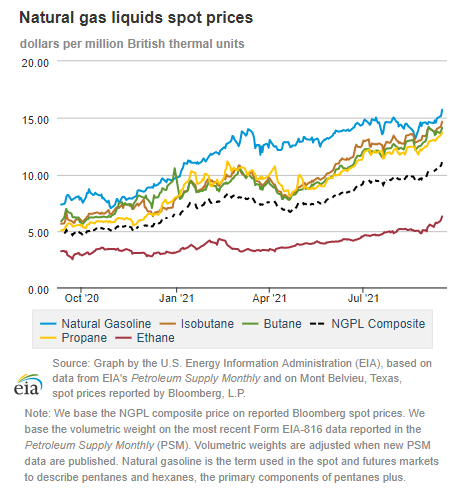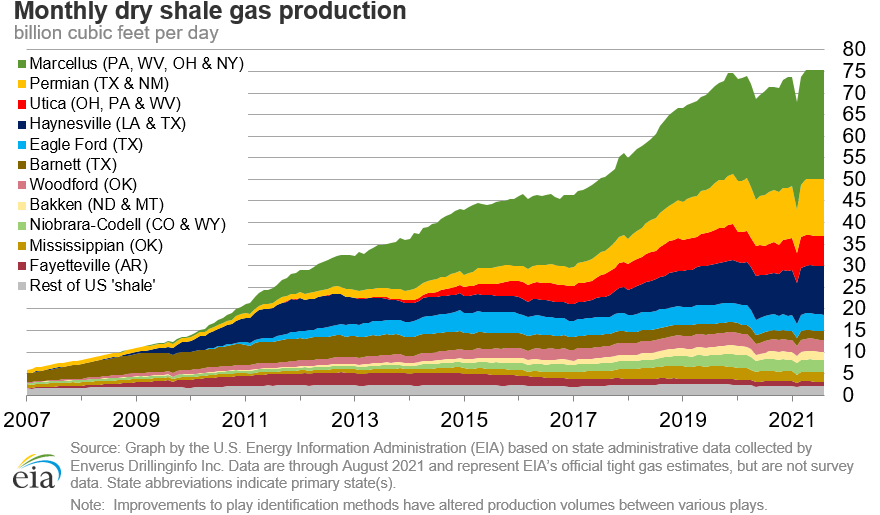In the News:
U.S. natural gas consumption to be lower in 2021 and 2022, led by the electric power sector
In EIA’s September Short-Term Energy Outlook, we expect U.S. consumption of natural gas to decline in 2021 and 2022 from 2020 levels. We forecast that consumption of natural gas will decline in all end-use sectors in the United States except in the industrial sector and for other non-sector-specific uses (e.g., lease and plant fuel, pipeline and distribution use, and vehicle use) in 2022. The largest decline will occur in the electric power sector. We expect total U.S. consumption of natural gas to average 82.5 billion cubic feet per day (Bcf/d) in 2021, down 0.7 Bcf/d from 2020. We expect U.S. natural gas consumption in 2022 to increase slightly from 2021 to 82.6 Bcf/d as increasing consumption in the industrial sector offsets declining consumption in the electric power sector, though total 2022 consumption still remains lower than the 2020 level.
In the United States, natural gas prices influence natural gas consumption in the electric power sector. When natural gas prices are high, generators typically switch from natural gas to coal, which can be a lower cost source for power generation. Higher prices at Henry Hub, the U.S. natural gas benchmark, during the first half of 2021 resulted in less natural gas consumption in the electric power sector compared with the first half of 2020. We expect the Henry Hub price to average $3.63 per million British thermal units (MMBtu) in 2021, $1.60/MMBtu more than the 2020 average. As a result, we expect natural gas consumption in the U.S. electric power sector to decline 2.7 Bcf/d, or 8.3%, in 2021. We expect another small decline (0.7 Bcf/d) in electric power sector consumption of natural gas in 2022 with forecast Henry Hub prices remaining elevated at $3.47/MMBtu and as natural gas faces more competition from renewable sources of electricity generation.
We expect natural gas consumption in the U.S. industrial sector to increase in 2022 to 23.8 Bcf/d from an average of 23.2 Bcf/d in 2021. Natural gas consumed by the industrial sector directly correlates to the level of industrial activity, which we measure in the STEO using a natural gas-weighted industrial consumption index. This index reflects the growth of manufacturing subsectors and their relative importance to U.S. natural gas consumption. We expect that the index will increase 5.8% in 2021 from 2020 levels and another 5.8% in 2022 from 2021 levels, reflecting continuing post-pandemic economic growth.
Overview:
(For the week ending Wednesday, September 15, 2021)
- Natural gas spot prices rose at most locations this report week (Wednesday, September 8 to Wednesday, September 15). The Henry Hub spot price rose from $4.78 per million British thermal units (MMBtu) last Wednesday to $5.60/MMBtu yesterday, reflecting a tightening natural gas market. Prices are also rapidly rising internationally. Bloomberg Finance, L.P. reports swap prices for October liquefied natural gas (LNG) cargos in East Asia rose to a weekly average of $18.69/MMBtu this report week, exceeding the previous record set in January of this year. At the Title Transfer Facility (TTF) in the Netherlands, the most liquid European natural gas spot market, prices averaged $17.96/MMBtu this report week, the highest weekly average on record going back to September 2007, up $2.56/MMBtu from $15.40/MMBtu last week. In the same week last year (week ending September 16, 2020) average prices in East Asia and at TTF were at $4.34/MMBtu and $3.11/MMBtu, respectively.
- The price of the October 2021 NYMEX contract increased 55¢, from $4.914/MMBtu last Wednesday to $5.460/MMBtu yesterday. The price of the 12-month strip averaging October 2021 through September 2022 futures contracts climbed 35¢/MMBtu to $4.669/MMBtu. Futures contracts for delivery in November, December, January, and February of the coming heating season all closed above $5.50/MMBtu, with December and January closing at $5.604/MMBtu and $5.676/MMBtu, respectively, the highest futures prices since the March 2014 contract closing prices in late February 2014.
- The net injections to working gas totaled 83 billion cubic feet (Bcf) for the week ending September 10. Working natural gas stocks totaled 3,006 Bcf, which is 17% lower than the year-ago level and 7% lower than the five-year (2016–2020) average for this week.
- The natural gas plant liquids composite price at Mont Belvieu, Texas, rose by 37¢/MMBtu, averaging $10.70/MMBtu for the week ending September 15. Normal butane prices fell 1%. Propane and natural gasoline prices rose 3%, while isobutane prices rose 2%, following a 1% increase in Brent crude oil prices. The propane premium over crude oil widened for the third consecutive week, increasing 69% to over $1.00/MMBtu for the week ending September 15. Strong global demand for propane, as well as lower OPEC+ production, have led to record-high exports and an upward pressure on prices. Ethane prices rose 8%, exceeding the increase in natural gas prices on the Houston Ship Channel, which rose on average 7% this report week. Because of numerous outages at polyethylene plants along the Gulf Coast following Hurricanes Ida and Nicholas, ethylene prices fell 13%, tightening the margin to crack ethane into ethylene, but ethane remains the preferred petrochemical cracking feedstock because the prices of other petrochemical feedstocks, such as propane, remain high.
- According to Baker Hughes, for the week ending Tuesday, September 7, the natural gas rig count decreased by 1 to 101, with the Marcellus Play in Pennsylvania losing 2 rigs, offset somewhat by a gain of 1 rig in Utah. The number of oil-directed rigs rose by 7, with largest gains reported in Louisiana, where 4 rigs were added as offshore drilling activity gradually returns after Hurricane Ida’s arrival led to a loss of all 14 rigs in Louisiana’s offshore in the previous report week. The total rig count increased by 6, and it now stands at 503.
Prices/Supply/Demand:
Prices rise in South Louisiana, reflecting continuing tightness as a result of curtailed production and strong demand. This report week (Wednesday, September 8 to Wednesday, September 15), the Henry Hub spot price rose 82¢ from $4.78/MMBtu last Wednesday to $5.60/MMBtu yesterday. The Bureau of Safety and Environmental Enforcement (BSEE) reported production from the offshore Gulf of Mexico was approximately 0.8 Bcf/d higher yesterday compared with last Wednesday, but it was still almost 0.9 Bcf/d below levels reported before Hurricane Ida. The landfall of Hurricane Nicholas on Monday, September 13, delayed recovery efforts along the Gulf Coast, causing widespread power outages in Texas and flooding in Louisiana. Despite decreased production, IHS Markit estimates feed gas to liquefied natural gas (LNG) export facilities in Louisiana increased week over week, rising 0.4 Bcf/d to 6.2 Bcf/d.
Prices at the Houston Ship Channel rose 57¢, from $4.93/MMBtu last Wednesday to $5.49/MMBtu yesterday. The smaller increase relative to the rise in Henry Hub prices reflects decreased demand following power outages in the Greater Houston area. CenterPoint Energy reports these outages peaked in its territory at 460,000 customers without power on Tuesday, resulting in natural gas consumption for power generation in South Texas declining on average 0.7 Bcf/d week over week. Feed gas to LNG facilities also fell this report week, as a result of a reported power outage at the Freeport LNG terminal south of Houston following Hurricane Nicholas, and compressor station maintenance (Notice ID 599) at Cheniere’s Corpus Christi terminal, which started yesterday and is planned to end September 19.
Midwest prices increase as temperatures reach above-normal levels. At the Chicago Citygate, the price increased 72¢ from $4.77/MMBtu last Wednesday to $5.49/MMBtu yesterday. Natural gas consumption for electric power generation in the Midwest increased 0.7 Bcf/d, or 39%, according to data from IHS Markit. Daily high temperatures in the Chicago area remained in the high 80’s from September 11 to September 14, from 10°F to 11°F above normal. IHS Markit reports net flows to Canada from the Midwest decreased 0.3 Bcf/d as in-region demand was strong this week.
Prices in California remain elevated, though in Southern California prices retreat from recent record highs. The price at PG&E Citygate in Northern California rose 79¢, up from $6.64/MMBtu last Wednesday to $7.43/MMBtu yesterday. The price rise reflects both rising demand and increasing prices in regions from which PG&E sources its natural gas. The price at Malin, Oregon, the northern delivery point into the PG&E service territory, rose 47¢ from $5.16/MMBtu last Wednesday to $5.63/MMBtu yesterday. The price at Sumas on the Canada-Washington border rose 52¢ from $5.00/MMBtu last Wednesday to $5.52/MMBtu yesterday. The price at Opal Hub in southwest Wyoming rose 49¢ from $5.08/MMBtu last Wednesday to $5.57/MMBtu yesterday. Demand in California also continues to rise, with natural gas consumption for power generation rising by 6% on average week over week, to 2.5 Bcf/d. Continuing drought conditions across the West have resulted in record-low water levels in reservoirs across California. According to our Electric Power Monthly data, the share of hydroelectric power generation in California fell from approximately 15% last June to 8% this June, the latest month for which data is available, resulting in greater dependence on natural-gas fired generation, which rose from 37% last June to 47% this June. Hydroelectric power generation fell from 84.5 gigawatthours (GWh) per day in June 2020 to 51.5 GWh/d in June 2021, the equivalent of losing almost 1.4 GW of generation capacity.
The price at SoCal Citygate in Southern California decreased $12.03 from $20.06/MMBtu last Wednesday to $8.03/MMBtu yesterday. Temperatures moderated somewhat in Southern California at the end of the report week, falling to 90°F, or 2°F below normal, yesterday in Riverside. The reduced demand in the region has resulted in prices at other Southwestern hubs also declining. Despite continuing constraints after Kinder Morgan declared force majeure on the El Paso Natural Gas (EPNG) Line 2000 in Arizona, Natural Gas Intelligence reported El Paso South Mainline/N. Baja price for deliveries into southern New Mexico and Arizona fell $20.56/MMBtu this report week to $8.21/MMBtu yesterday, from $28.77/MMBtu last Wednesday, the highest price since the mid-February winter storm.
Above-normal temperatures result in higher natural gas demand for power generation, causing prices to rise in the Northeast. At the Algonquin Citygate, which serves Boston-area consumers, the price went up 96¢ from $4.49/MMBtu last Wednesday to $5.45/MMBtu yesterday, after reaching a weekly high of $5.50/MMBtu on Tuesday. At the Transcontinental Pipeline Zone 6 trading point for New York City, the price increased 87¢ from $4.36/MMBtu last Wednesday to a weekly high of $5.23/MMBtu yesterday. Daily high temperatures in Boston swung from 73°F, or 1°F below normal, on Tuesday, to 86°F, or 12°F above normal, yesterday, resulting in New England natural gas consumption for power generation rising about 0.3 Bcf/d, to the highest levels since late August, according to IHS Markit. Temperatures in New York’s Central Park also rose rapidly, from an already elevated daily high of 80°F, or 3°F above normal, on Tuesday to 85°F, or 8°F above normal, yesterday, resulting in natural gas consumption for power generation rising in the New York/New Jersey area by more than 0.4 Bcf/d yesterday.
Strong in-region demand, and continuing elevated flows to the South, result in rapid price increases in the Appalachian production region. The Tennessee Zone 4 Marcellus spot price increased 88¢ from $4.13/MMBtu last Wednesday to $5.01/MMBtu yesterday. The price at Eastern Gas South in southwest Pennsylvania rose 90¢ from $4.17/MMBtu last Wednesday to $5.07/MMBtu yesterday. Both hubs reached weekly highs yesterday, as a combination of above-normal temperatures in the Northeast and Midwest, where most Appalachian gas flows, and continuing decreases in production in the South, resulted in some of the highest outflows of natural gas from the region on record. IHS Markit estimates pipeline flows out of the Appalachian region averaged 25.9 Bcf/d for the second week in a row, the highest weekly averages for September on record.
Prices in the Permian production area rise, but not as fast as prices in other regions. The price at the Waha Hub in West Texas, which is located near Permian Basin production activities, rose 66¢/MMBtu this report week, from $4.63/MMBtu last Wednesday to $5.29/MMBtu yesterday. The Waha discount relative to the Henry Hub widened by 16¢/MMBtu, reflecting the impact of lower prices in the Southwest and tightening conditions at Henry-Hub, as covered in the section on South Louisiana above. The Waha Hub traded 31¢/MMBtu below the Henry Hub price yesterday, compared with last Wednesday when it traded 15¢/MMBtu below the Henry Hub price.
U.S. supply increases as production begins to come back online in the Gulf of Mexico. According to data from IHS Markit, the average total supply of natural gas rose by 1.7% compared with the previous report week. Dry natural gas production grew by 1.4%, or 1.3 Bcf/d, compared with the previous report week. According to daily reports from BSEE, on a weekly basis, natural gas production outages in the Federal Offshore Gulf of Mexico (GOM) decreased by about 0.6 Bcf/d this report week compared with the last report week as operators in the GOM return to platforms and rigs following Hurricane Ida. Other increases in production came from Texas and the Midcontinent, according to data from IHS Markit. Average net imports from Canada increased by 7.6% from last week.
Consumption of natural gas rises, driven by an increase in the electric power sector. Total U.S. consumption of natural gas rose by 2.6% compared with the previous report week, according to data from IHS Markit. Natural gas consumed for power generation climbed by 3.4%, or 1.1 Bcf/d, week over week as temperatures in the West and Midcontinent were higher than normal. Industrial sector consumption increased by 0.8% week over week. In the residential and commercial sectors, consumption increased by 4.3%, or 0.3 Bcf/d. Natural gas exports to Mexico decreased 6.9% to 5.5 Bcf/d. Natural gas deliveries to U.S. LNG export facilities (LNG pipeline receipts) averaged 10.4 Bcf/d, or 0.44 Bcf/d lower than last week.
U.S. LNG exports decrease week over week. Sixteen LNG vessels (five from Sabine Pass, four from Corpus Christi, three from Freeport, two from Cameron, and one each from Cove Point and Elba Island) with a combined LNG-carrying capacity of 56 Bcf departed the United States between September 9 and September 15, 2021, according to shipping data provided by Bloomberg Finance, L.P.
Storage:
The net injections into storage totaled 83 Bcf for the week ending September 10, compared with the five-year (2016–2020) average net injections of 79 Bcf and last year's net injections of 86 Bcf during the same week. Working natural gas stocks totaled 3,006 Bcf, which is 231 Bcf lower than the five-year average and 595 Bcf lower than last year at this time.
According to The Desk survey of natural gas analysts, estimates of the weekly net change to working natural gas stocks ranged from net injections of 69 Bcf to 85 Bcf, with a median estimate of 77 Bcf.
The average rate of injections into storage is 14% lower than the five-year average so far in the refill season (April through October). If the rate of injections into storage matched the five-year average of 9.5 Bcf/d for the remainder of the refill season, the total inventory would be 3,488 Bcf on October 31, which is 231 Bcf lower than the five-year average of 3,719 Bcf for that time of year.
More storage data and analysis can be found on the Natural Gas Storage Dashboard and the Weekly Natural Gas Storage Report.
See also:
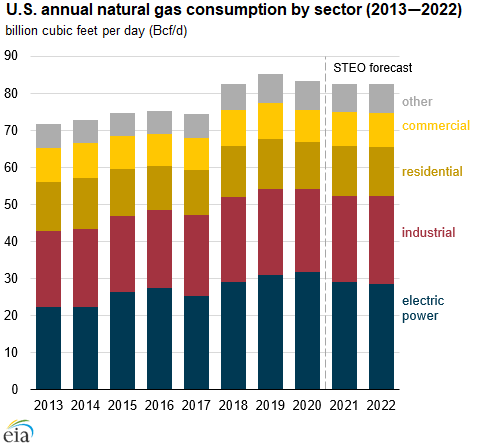 Source: U.S. Energy Information Administration, Short-Term Energy Oulook
Source: U.S. Energy Information Administration, Short-Term Energy Oulook
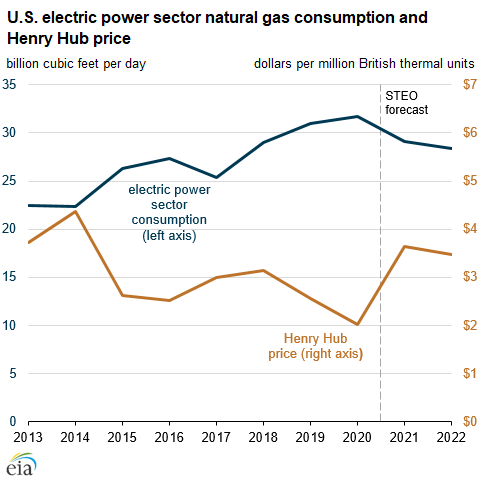 Source: U.S. Energy Information Administration, Short-Term Energy Oulook
Source: U.S. Energy Information Administration, Short-Term Energy Oulook
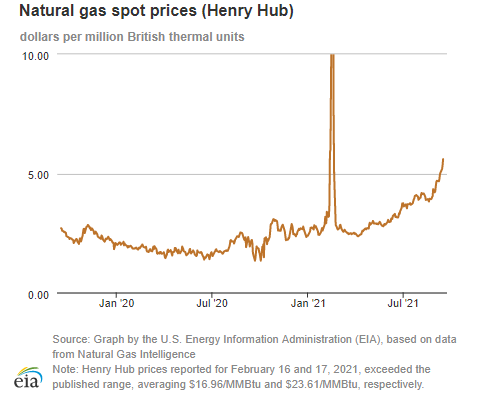
| Spot Prices ($/MMBtu) | Thu, 09-Sep |
Fri, 10-Sep |
Mon, 13-Sep |
Tue, 14-Sep |
Wed, 15-Sep |
|---|---|---|---|---|---|
| Henry Hub |
4.97 |
5.04 |
5.18 |
5.35 |
5.60 |
| New York |
4.17 |
4.34 |
4.95 |
5.17 |
5.23 |
| Chicago |
4.77 |
4.82 |
5.10 |
5.13 |
5.49 |
| Cal. Comp. Avg.* |
6.59 |
6.13 |
6.70 |
6.78 |
6.63 |
| Futures ($/MMBtu) | |||||
| October contract | 5.031 |
4.938 |
5.231 |
5.260 |
5.460 |
| November contract |
5.072 |
4.973 |
5.273 |
5.305 |
5.507 |
| *Avg. of NGI's reported prices for: Malin, PG&E Citygate, and Southern California Border Avg. | |||||
| Source: NGI's Daily Gas Price Index | |||||
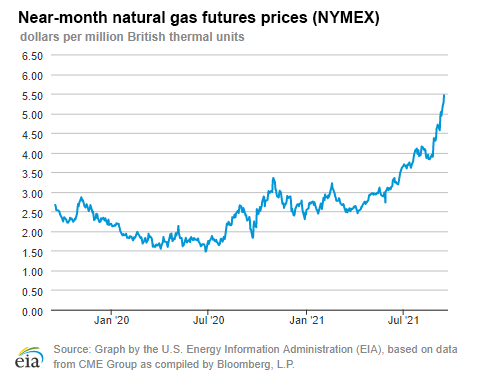
| U.S. natural gas supply - Gas Week: (9/9/21 - 9/15/21) | |||
|---|---|---|---|
Average daily values (billion cubic feet) |
|||
this week |
last week |
last year |
|
| Marketed production | 103.8 |
102.2 |
101.6 |
| Dry production | 92.3 |
91.0 |
89.7 |
| Net Canada imports | 4.8 |
4.5 |
3.9 |
| LNG pipeline deliveries | 0.1 |
0.1 |
0.1 |
| Total supply | 97.2 |
95.5 |
93.7 |
|
Source: Chart by the U.S. Energy Information Administration (EIA), based on data from IHS Markit | |||
| U.S. natural gas consumption - Gas Week: (9/9/21 - 9/15/21) | |||
|---|---|---|---|
Average daily values (billion cubic feet) |
|||
this week |
last week |
last year |
|
| U.S. consumption | 63.6 |
62.0 |
65.6 |
| Power | 34.1 |
33.0 |
35.3 |
| Industrial | 21.0 |
20.9 |
21.6 |
| Residential/commercial | 8.4 |
8.1 |
8.7 |
| Mexico exports | 5.5 |
5.9 |
5.8 |
| Pipeline fuel use/losses | 6.2 |
6.0 |
6.1 |
| LNG pipeline receipts | 10.4 |
10.9 |
6.8 |
| Total demand | 85.6 |
84.7 |
84.4 |
|
Source: Chart by the U.S. Energy Information Administration (EIA), based on data from IHS Markit | |||
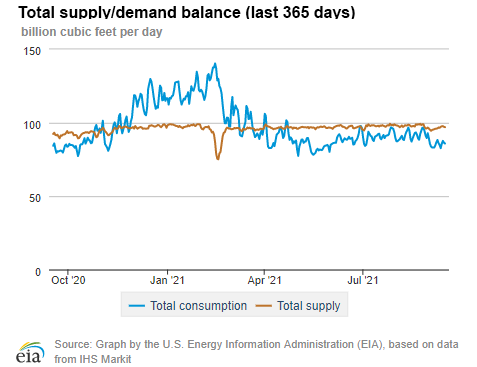
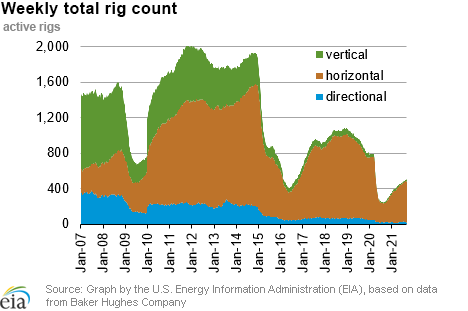
| Rigs | |||
|---|---|---|---|
Tue, September 07, 2021 |
Change from |
||
last week |
last year |
||
| Oil rigs | 401 |
1.8% |
122.8% |
| Natural gas rigs | 101 |
-1.0% |
42.3% |
| Note: Excludes any miscellaneous rigs | |||
| Rig numbers by type | |||
|---|---|---|---|
Tue, September 07, 2021 |
Change from |
||
last week |
last year |
||
| Vertical | 26 |
13.0% |
36.8% |
| Horizontal | 461 |
-0.4% |
115.4% |
| Directional | 16 |
45.5% |
-23.8% |
| Source: Chart by the U.S. Energy Information Administration (EIA), based on data from Baker Hughes Company | |||
| Working gas in underground storage | ||||
|---|---|---|---|---|
Stocks billion cubic feet (Bcf) |
||||
| Region | 2021-09-10 |
2021-09-03 |
change |
|
| East | 732 |
703 |
29 |
|
| Midwest | 876 |
842 |
34 |
|
| Mountain | 193 |
191 |
2 |
|
| Pacific | 240 |
243 |
-3 |
|
| South Central | 965 |
943 |
22 |
|
| Total | 3,006 |
2,923 |
83 |
|
|
Source: U.S. Energy Information Administration Form EIA-912, Weekly Underground Natural Gas Storage Report | ||||
| Working gas in underground storage | |||||
|---|---|---|---|---|---|
Historical comparisons |
|||||
Year ago (9/10/20) |
5-year average (2016-2020) |
||||
| Region | Stocks (Bcf) |
% change |
Stocks (Bcf) |
% change |
|
| East | 822 |
-10.9 |
783 |
-6.5 |
|
| Midwest | 979 |
-10.5 |
897 |
-2.3 |
|
| Mountain | 220 |
-12.3 |
202 |
-4.5 |
|
| Pacific | 310 |
-22.6 |
291 |
-17.5 |
|
| South Central | 1,271 |
-24.1 |
1,064 |
-9.3 |
|
| Total | 3,601 |
-16.5 |
3,237 |
-7.1 |
|
| Source: U.S. Energy Information Administration Form EIA-912, Weekly Underground Natural Gas Storage Report | |||||
| Temperature – heating & cooling degree days (week ending Sep 09) | ||||||||
|---|---|---|---|---|---|---|---|---|
HDDs |
CDDs |
|||||||
| Region | Current total |
Deviation from normal |
Deviation from last year |
Current total |
Deviation from normal |
Deviation from last year |
||
| New England | 8 |
-7 |
4 |
13 |
3 |
-13 |
||
| Middle Atlantic | 6 |
-3 |
4 |
20 |
-3 |
-20 |
||
| E N Central | 12 |
-1 |
-1 |
18 |
-4 |
-9 |
||
| W N Central | 9 |
-10 |
-13 |
37 |
6 |
-1 |
||
| South Atlantic | 1 |
-1 |
0 |
73 |
1 |
-20 |
||
| E S Central | 1 |
-1 |
1 |
60 |
-4 |
-21 |
||
| W S Central | 0 |
-1 |
0 |
116 |
18 |
5 |
||
| Mountain | 2 |
-22 |
-12 |
66 |
17 |
-9 |
||
| Pacific | 1 |
-7 |
0 |
62 |
27 |
-14 |
||
| United States | 5 |
-5 |
-1 |
53 |
7 |
-12 |
||
|
Source: Chart by the U.S. Energy Information Administration (EIA), based on data from the National Oceanic and Atmospheric Administration Note: HDDs=heating degree days; CDDs=cooling degree days | ||||||||
Average temperature (°F)
7-day mean ending Sep 09, 2021
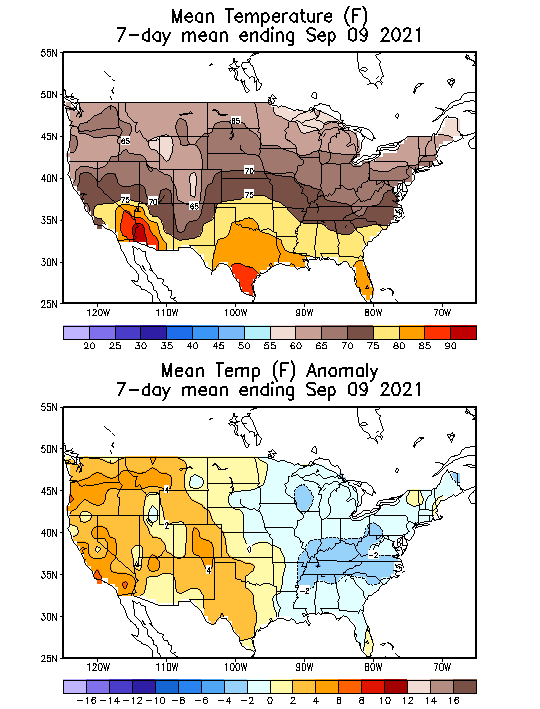
Source: National Oceanic and Atmospheric Administration
Deviation between average and normal (°F)
7-day mean ending Sep 09, 2021

Source: National Oceanic and Atmospheric Administration

